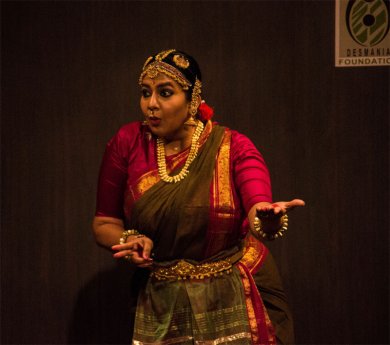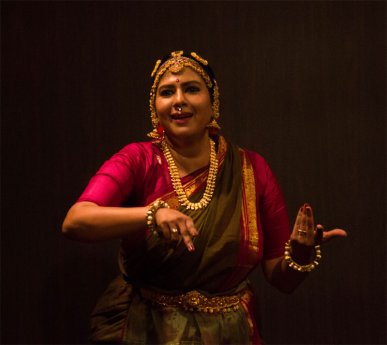
|   |

|   |
 e-mail: leelakaverivenkat@gmail.com Evoking a feel of the Sadir dancer's joi de vivre April 27, 2018  Sandhya Raman's Art Studio has been a venue for some out- of- the way evenings of dance. Now with one end of the L shaped hall given a neatly erected wooden stage just a foot above the floor level with the audience seated on modhas in front, the performer has his/her space defined, with the intimate ambience preserved. And marking Tamil New Year's day, was a most entertaining evening of Stories that take a form devised and performed by scholar /performer Swarnamalya Ganesh from Chennai, who with years of research into the cultural, sociological, political history of what we call Bharatanatyam today, has worked at trying to reconstruct the old avatars of the dance - this evening's concern being with its manifestation as Sadir performed by the devadasis - the period dealt with being roughly from early 1700 till about 1920. In the then Madras Presidency, the dance had a very visible presence. The old diaries, records and gazetteers contain plenty of scattered bits of information and culling the details to be able to get out of it sufficient material to construct a dance edifice, is the unstinting work of Swarnamalya who acknowledges generously the help of other researchers of history, Tamil literature etc in this effort. The memories from the past began right from the introduction to each item, the dancer's histrionics bringing alive the British dorai and the plantation owner, the Dubhash or any character featured in the interaction. The story begins with The Luz House of Moddaverappa Venkatasami Naidu, where several kutcheris were held - a famous place visited by renowned musicians like Sonti Venkataramana and even Tyagaraja. The dancer's Sadir team of musicians (Sangeetha providing vocal support, Subhalakshmi on the nattuvangam, K. Parthasarathy on mridangam with Manish on the harmonium) began with a Tyagaraja kriti "Mamava Raghurama" in Saranga. Moving on, the narrative now moves on to an incident of August 17th 1727, from the Fort St. George diary, when Dubhash Srirangaraja and his Secretary Dubhash Pindikuri Venkatadri, entertained Major John who, accompanied by the victory sounds of kettle drums arrived at Fort St. George. The reception party with the Dubhash and his secretary, apart from a grand welcome with an opulent deer party including entertainment in the "master's humble garden," had none other than the famous dancer Tanjavur Manga herself performing a varnam in Karnataka Kapi composed by the Tanjore Quartette in praise of Brihadeeswara, "Sarasu ninnu marimanara vinara chelamelara" in tisra ekam talam. Following the theatrics of the introduction, Swarnamalya becomes the dancer, entering with a demure and seductive walk and greets with a namaskaram the assembled dignitaries- the dancer's animated presence with a mischievous glint in the eyes radiates a sense of joy and pure fun, the bright eyed glances and the entire presentation designed with the aim of beguiling the viewer. Expressing her deep love for Brihadeeswara, the sagara of karuna the charanam part Ra ra swami, when she beseeches the Lord by calling out to him to come to her, was a peaking point, performed with conviction. In the dance interpretation, there was great emphasis on the sahitya part with the teermanams forming the nritta punctuations, kept sure footed and short - without the kind of elongated jatis dancers today seem to have in their varnam presentations, to the extent of diluting the total integrity of the musical composition. The musicians were all of a piece with the dance. The story next moves to Nungambakkam which in those days was called Bommarajapuram and the Dubhash was Devanayaka who had served under Col. Ford and the famous Eyre Coote and had the distinction of participating in the battle of Wandiwash, the anglicised term for Vandavasi. Devanayaka's son was Dubhash Subbaraya. The dancer in question for an occasion was Salem Meenakshi who learnt padams and javalis from Patnam Subramani Iyer. And Swarnamalya presented a rare Kshetrayya padam in Sankarabharanam set to adi talam, which, very different from his usual homage to Moova Gopala is dedicated to Adivaraha, the presiding deity of Mahadevapatnam Fort in Mannargudi. The devadasi expertise as a community extended over a wide range - and they were equally at ease with the sacred, the secular and the profane - and Swarnamalaya's insouciance, in dealing with the situation in the padam, where the nayika, nobody's fool, asks for her pound of flesh from the person who seeks favours from her, struck the right air of confidence, and liberated woman, with a lurking suggestion of hasya. The lyric set to Shankarabharanam has the nayika say, "O scheming Vittaraya, I have had dealings with a dozen men more skilful than you. You will make love to me today, not tomorrow. Put your money down first (before we talk)." A great love for life, but with a lived experience which made sure that one was not taken for a ride by any man, characterised the attitude of the nayika. The matter of fact manner of tucking the money away in the saree fold at the waist, while she gets ready to entertain the client, displayed no awkwardness.  When the Chennakeshava temple was built at Manali by Muthukrishna Mudali, Karur Sivaramayya wrote the famous Javali "O my lovely Lalana." This composition in Karaharapriya set to adi talam, which dancers know about, shows how it was not so much the beauty of poetry (in fact many would judge it as the sign of the worst decadence) but its ability to communicate across cultures and language barriers held no fears for these dancers. The devadasi who presented this javali was Kanakambujam who lived in Chetti Street of George Town. O my lovely Lalana Elane Pommanti (why do you dismiss me) Ituvanti (such a) Step, is it fit to take? Sit a while here Let me convince you. The sheer ability to push boundaries and go beyond conventional performance rules in Sadir performers, reveals (apart from a situation where their support system was in dire threat), an adventurous inclusivity, not daunted by having to tether their dance to poetry in different languages. The Tamil Arabic descent had familiarised dancers with languages like Persian and Urdu. Living in Kanchanwada in Triplicane was Kanchani Nazeera Banu in the court of Sadathullah Khan. The Carnatic Muslim Nawabs of Arcot had many poets in their court like Shahtura Tirunamali (Tiruneermalai), Sherif Madras Latif Arcoti (Arcot) and Hazrat Qurbi Vellori, and very popular for his Urdu poetry was Moulana Baqhir Aga Vellori (from Vellore and Trichy). Swarnamalya interpreted a two line song rendered like a thumri in the raga Charukesi "Dil me dildar nihata, mujhe malum na tha." On March 22 of 1911 came the proclamation of King George and Queen Mary arriving in India for the Delhi Durbar. The dance and music world was agog with frenzy. The Muthialpet Sangeetha Sabha announced that people could come forward with compositions suitable for the occasion - attracting even greats like Harikeshnallur Muttiah Bhagavatar! On Pilli Narasimha Chetty Street lived Pilli Narasimha Rao who wrote the British Anthem in Sanskrit. Georgi Nama was chanted for the new tapatraya deva. Carnatic music had now the ‘Nottuswarams' written, arranged and played by Reverend Schwartz's Band. And this music was used even in the temple processions of Chenna Maleswar and Kapaleswar. And even one of Carnatic music's Trimurtis, Muthuswamy Dikshitar listening to the band practice daily was inspired to make his own creations! The high spirit of participation notwithstanding the uncertainties of life in a changing social and political situation of these Sadir women says a lot for their courage and sheer spirit of undaunted fun. Swarnamalya succeeded in being able to evoke that feel of a light hearted, enjoyable evening of dance with no pomposity - and seldom does one see Bharatanatyam of today evoke such a mood.  Writing on the dance scene for the last forty years, Leela Venkataraman's incisive comments on performances of all dance forms, participation in dance discussions both in India and abroad, and as a regular contributor to Hindu Friday Review, journals like Sruti and Nartanam, makes her voice respected for its balanced critiquing. She is the author of several books like Indian Classical dance: Tradition in Transition, Classical Dance in India and Indian Classical dance: The Renaissance and Beyond. Post your comments Please provide your name and email id when you use the Anonymous profile in the blog to post a comment. All appropriate comments posted with name & email id in the blog will also be featured in the site. |